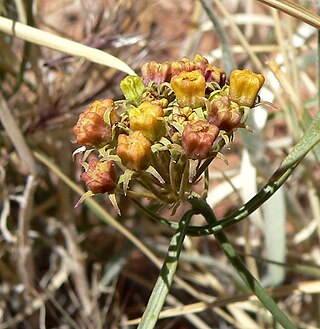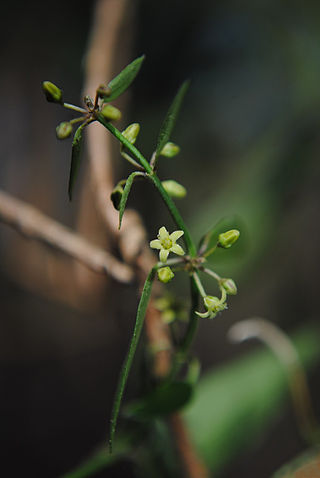
Cynanchum is a genus of about 300 species including some swallowworts, belonging to the family Apocynaceae. The taxon name comes from Greek kynos and anchein, hence the common name for several species is dog-strangling vine. Most species are non-succulent climbers or twiners. There is some evidence of toxicity.

Dogbane, dog-bane, dog's bane, and other variations, some of them regional and some transient, are names for certain plants that are reputed to kill or repel dogs; "bane" originally meant "slayer", and was later applied to plants to indicate that they were poisonous to particular creatures.
Swallowwort or swallow-wort is a common name for several plants and plant families. The term may be a description of poisonous effects, or indicate that a plant was formerly used medicinally for tonsillitis.

Vincetoxicum rossicum is a flowering plant in the family Apocynaceae. It is a perennial herb native to southern Europe and is a highly invasive plant growing in all of the Eastern United States, in the mid west, and southern Ontario and Quebec in Canada. It has several common names including swallowwort, pale swallowwort, and dog-strangling vine; though it does not actually strangle dogs, it can “strangle” native plants and small trees if it is in dense patches. There has historically been much confusion about the genus it belongs to, with authors placing it within Vincetoxicum and others within Cynanchum, but recent molecular and chemical analyses have shown it to belong in the genus Vincetoxicum.

Metastelma is a genus of plant in the family Apocynaceae first described in 1810.

Sarcostemma is a formerly recognized genus of flowering plants in the dogbane family, Apocynaceae, first described as a genus in 1810. The name is derived from the Greek words σαρκὸς (sarkos), meaning "flesh," and στέμμα (stemma), meaning "garland". Members of the genus were known generally as climbing milkweeds or caustic bushes. The genus Sarcostemma has been shown to be nested within the genus Cynanchum, and in 2012 Sarcostemma was put into synonymy with Cynanchum.

Vincetoxicum is a genus of plants in the family Apocynaceae. Although the species in Vincetoxicum have sometimes been included in Cynanchum, chemical and molecular evidence shows that Vincetoxicum is more closely related to Tylophora, now included in Vincetoxicum. The generic name means "poison-beater" in Botanical Latin because of the plants' supposed antidotal effects against snakebite.

Funastrum utahense, synonym Cynanchum utahense, is a species of flowering plant in the genus Funastrum of the family Apocynaceae, known by the common names Utah swallow-wort and Utah vine milkweed. This relatively uncommon perennial vine is native to the Mojave Desert from California, Nevada, Utah and Arizona in the United States. This is a small vine with a highly branched, twining stem rarely exceeding a meter in length with which it physically supports itself on other shrubs and trees. It has small narrow leaves a few centimeters long. Its flowers are bright yellow to orange and grow in umbels. The fruit is a grooved follicle several centimeters long.

Vincetoxicum hirundinaria, commonly named white swallow-wort, is a long-lived herbaceous perennial of the genus Vincetoxicum in the family Apocynaceae.

Vincetoxicum nigrum, a species in the family Apocynaceae, also known as black swallow-wort, Louise's swallow-wort, or black dog-strangling vine, is a species of plant that is native to Europe and is found primarily in Italy, France, Portugal, and Spain. It is an invasive plant species in the northeastern United States, parts of the Midwest, southeastern Canada, and California. In 2020, wild plants were found in Timaru, New Zealand.

Cynanchum laeve is a vining perennial herb native to eastern and central U.S. states and Ontario. Common names include sand vine, honeyvine, honeyvine milkweed, bluevine milkweed, climbing milkweed, and smooth swallow-wort. The root system of C. laeve can cause it to be very difficult to eradicate, especially in agricultural fields. It is a larval food of monarch butterflies and milkweed tussock moth larvae. C. laeve can cause eye irritation if touched and can be toxic to humans and livestock if consumed in large quantities.

Cynanchum viminale is a leafless succulent plant in the family Apocynaceae. The species is native to West Africa, the Indian Ocean and Western Pacific region. The species' natural range extends from South Africa throughout much of Africa and the Middle East to India, Indochina, Southern China, Indomalaya and into Meganesia. The species is also found on several Indian Oceans islands including Mauritius, Réunion and the Seychelles.

Diplolepis is a plant genus in the family Apocynaceae, first described as a genus in 1810. It is native to southern South America.
- Diplolepis boerhaviifolia - Chile
- Diplolepis descolei - Argentina
- Diplolepis geminiflora - Chile
- Diplolepis hieronymi - Argentina
- Diplolepis menziesii - Chile
- Diplolepis nummulariifolia - Chile
- D. apiculata, syn of Tylophora hirsuta
- D. longirostrum, syn of Cynanchum longirostrum
- D. ovata, syn of Tylophora ovata
- D. variabilis, syn of Cynanchum atacamense
- D. vomitoria, syn of Tylophora asthmatica

Cynanchum ellipticum is a South African climbing plant of the family Apocynaceae, with slender stems and branches, exuding milky, bitter latex that is non-irritant. It occurs in coastal scrub from Cape Town as far north as Mozambique and further inland up to 1300 m, and may be found on flats or moderate slopes, in sand or between rocks, in indigenous forests and along forest margins and thickets, frequently occurring in disturbed habitats.
Metastelma arizonicum, synonym Cynanchum arizonicum, the Arizona swallow-wort or Arizona climbing milkweed, is a plant native to Arizona, New Mexico and Sonora. It is a twining, herbaceous vine with whitish to yellow flowers, growing on rocky slopes and in canyons of desert mountain ranges.

Orthosia is a genus of plants in the family Apocynaceae, first described as a genus in 1844.

The milkweed leaf beetle is a species of leaf beetle from the family Chrysomelidae. It is round bodied, 8–11 mm in length with a black head and pronotum and bright orange to yellow elytra with variable mottled black patches. Its colored and shaped like a super-sized ladybird beetle even though the ladybird is in a different family, Coccinellidae. The larva is shaped much like the adult except with a small tail extension. Its color varies from bright orange to white with a gray to black pronotum and prominent black spots around its spiracles.
Pattalias palustris is a plant species in the family Apocynaceae, also known as Gulf Coast swallow wort. It is native to the southeastern United States from North Carolina to Texas, and to Mexico, Belize, Cuba, the Bahamas, Turks and Caicos Islands, and Cayman Islands.
Cynanchum hooperianum is an Asian species of liana in the family Apocynaceae. Its known distribution includes: Guangxi, Indochina, Java and Sulawesi. In Vietnam it grows in the south of the country and may be called trâm hùng. Before 2016, it had been placed in the genera Oxystelma and Raphistemma.














